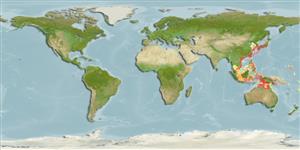>
Eupercaria/misc (Various families in series Eupercaria) >
Labridae (Wrasses) > Bodianinae
Etymology: Choerodon: Greek, choiros = a pig + odous = teeth (Ref. 45335); referrring to the prominent anterior canines of the species in this genus (Ref. 116605).
More on authors: Jordan & Snyder.
Environment: milieu / climate zone / depth range / distribution range
Ökologie
seewasser riff-verbunden, usually 8 - 50 m (Ref. 27115). Subtropical; 23°C - 28°C (Ref. 27115)
Western Pacific: southern Japan, Korean Peninsula, Taiwan, and the China seas.
Size / Gewicht / Alter
Maturity: Lm ? range ? - ? cm
Max length : 40.0 cm TL Männchen/unbestimmt; (Ref. 90102)
Rückenflossenstacheln (insgesamt): 13; Rückenflossenweichstrahlen (insgesamt): 7; Afterflossenstacheln 3; Afterflossenweichstrahlen: 10. Body anterior to wedge in adults somewhat dusky, paler posteriorly. Body with an anteroventrally angled narrow dusky wedge extending from base of tenth or eleventh dorsal-fin spine to posterior side of pectoral-fin base. Scales on subopercle reaching to or nearly to below anterior extent of ventral preopercular edge; predorsal scales reaching nearly to above posterior extent of orbit on dorsal midline of head (somewhat short of this in very large specimens). Juveniles somewhat mottled, but with a faint indication of above pattern and an ocellated dark spot posteriorly on dorsal fin.
Adults are found near shore in rock bottom (Ref. 11230). Oviparous, distinct pairing during breeding (Ref. 205). In Hong Kong live fish markets (Ref. 27253).
Life cycle and mating behavior
Geschlechtsreife | Fortpflanzung | Ablaichen | Eier | Fecundity | Larven
Pelagic spawner. Oviparous, distinct pairing during breeding (Ref. 205).
Masuda, H., K. Amaoka, C. Araga, T. Uyeno and T. Yoshino, 1984. The fishes of the Japanese Archipelago. Vol. 1. Tokai University Press, Tokyo, Japan. 437 p. (text). (Ref. 559)
IUCN Rote Liste Status (Ref. 130435)
Bedrohung für Menschen
Harmless
Nutzung durch Menschen
Aquarium: Kommerziell
Mehr Information
ReferenzenAquakulturAquakultur ProfilZuchtlinienGenetikElectrophoresesVererbbarkeitKrankheitenVerarbeitungNutrientsMass conversion
PartnerBilderStamps, Coins Misc.LauteCiguateraGeschwindigkeitSchwimmstilKiemenoberflächeOtolithsGehirngrößeSehfähigkeit
Tools
Zusatzinformationen
Download XML
Internet Quellen
Estimates based on models
Preferred temperature (Ref.
123201): 20.4 - 28.9, mean 27.7 °C (based on 718 cells).
Phylogenetic diversity index (Ref.
82804): PD
50 = 0.5000 [Uniqueness, from 0.5 = low to 2.0 = high].
Bayesian length-weight: a=0.01698 (0.00689 - 0.04188), b=3.03 (2.81 - 3.25), in cm total length, based on LWR estimates for this (Sub)family-body shape (Ref.
93245).
Trophic level (Ref.
69278): 3.5 ±0.37 se; based on food items.
Widerstandsfähigkeit (Ref.
120179): mittel, Verdopplung der Population dauert 1,4 - 4,4 Jahre. (Preliminary K or Fecundity.).
Fishing Vulnerability (Ref.
59153): Low to moderate vulnerability (30 of 100).
Nutrients (Ref.
124155): Calcium = 27.3 [12.6, 57.3] mg/100g; Iron = 0.529 [0.281, 1.108] mg/100g; Protein = 18.9 [16.0, 21.2] %; Omega3 = 0.164 [0.090, 0.293] g/100g; Selenium = 16.2 [7.4, 33.1] μg/100g; VitaminA = 40 [10, 217] μg/100g; Zinc = 0.739 [0.465, 1.309] mg/100g (wet weight);
